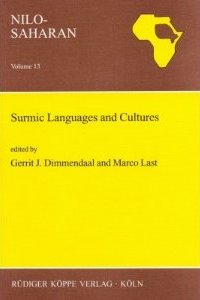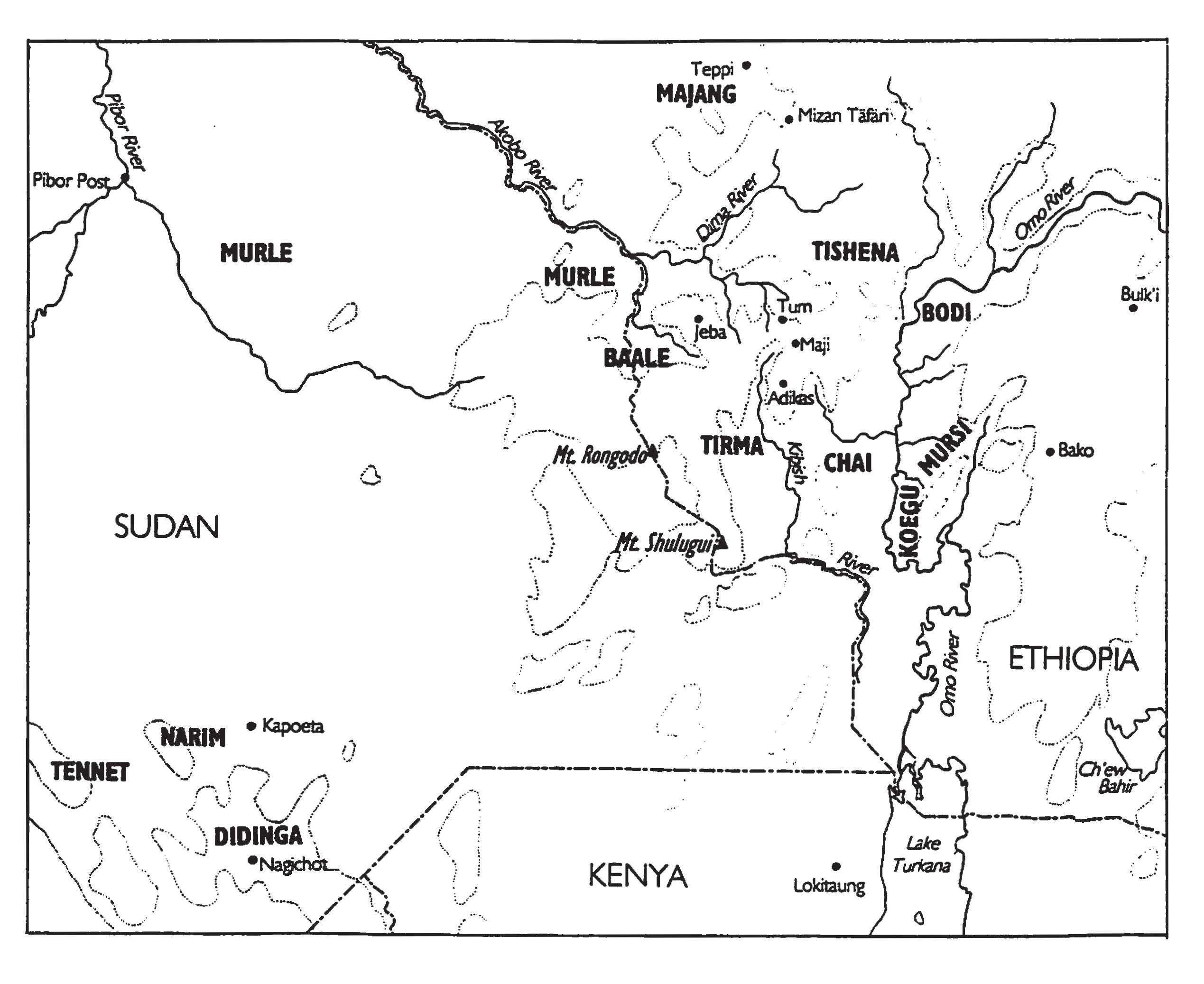

Surmic Languages and Cultures
Edited by: Gerrit J. Dimmendaal, Marco Last. With contributions by: Jon Abbink, Jonathan Arensen, Gerrit J. Dimmendaal, Osamu Hieda, Marco Last, Deborah Lucassen, Moges Yigezu, Scott Randal, Peter Unseth, Hans-Georg Will. Series edited by: M. Lionel Bender †, Franz Rottland †, Norbert Cyffer.
Series: NISA Nilo-Saharan – Studies in Language and Context Volume 13
19988 pp. Roman, 458 pp.
2 maps, 2 b/w photographs, 2 genealogical charts, 4 language tree models, numerous tables, charts and tone diagrams
Text language(s): English
E-book
€ 69.80
Buy 'Surmic Languages and Cultures' as a downloadable PDF document directly from our online shop »
The present study deals with the Surmic language group, spoken in southwestern Ethiopia and in the southern Sudan. Until recently, these languages were among the least studied on the African continent.
The editors reunite the analytical study of languages and the investigation of the social dimension of language structure. For them areal diffusion and language contact play an important role in the understanding of formal linguistic matters. The present volume contains a series of pioneering studies addressing synchronic and diachronic aspects of these little known languages.
CONTENTS
Part I GENERAL
Gerrit J. Dimmendaal: Surmic Languages and cultures – An introduction
Gerrit J. Dimmendaal: A syntactic typology of the Surmic family from an areal and historical-comparative point of view
Moges Yigezu: Women in society and female speech among the Suri of Southwestern Ethiopia
Peter Unseth / Jon Abbink: Cross-ethnic clan identities among Surmic groups and their neighbours – The case of the Mela
Peter Unseth: Two old causative affixes in Surmic languages
Jon Abbink / Peter Unseth: Surmic languages and cultures – A bibliography
Part II NORTHERN SURMIC
Peter Unseth: Notes on clan, kinship and marriage patterns among the Manjang
Part III SOUTHWESTERN SURMIC
Jonathan Arensen: Murle categorization
Scott Randal: A grammatical sketch of Tennet
Moges Yigezu / Gerrit J. Dimmendaal: Notes on Baale
Part IV SOUTHEASTERN SURMIC
Jon Abbink: Violence and political discourse among the Chai Suri
Osamu Hieda: A sketch of Koegu grammar – Towards reconstructing Proto-Southeastern Surmic
Marco Last / Deborah Lucassen: A grammatical sketch of Chai, a Southeastern Surmic language
Hans-Georg Will: The Me’en verb system – Does Me’en have tenses?
Under these links you will find descriptions of further Surmic languages and cultures:
Accompanying material:
- Current Research in Nilo-Saharan
(ISBN 978-3-89645-669-4 ) - Predicaments of Mursi (Mun) Women in Ethiopia’s Changing World
(ISBN 978-3-89645-833-9 ) - Suri Orature
(ISBN 978-3-89645-289-4 )
Cross-reference:
- Anthropology as Homage
(ISBN 978-3-89645-842-1 ) - APAL Annual Publication in African Linguistics
(ISBN 978-3-89645-503-1 ) - APAL Annual Publication in African Linguistics
(ISBN 978-3-89645-504-8 ) - Die Wandernde ist eine Kuh
(ISBN 978-3-89645-822-3 ) - The Bashada of Southern Ethiopia
(ISBN 978-3-89645-825-4 ) - To Live with Others
(ISBN 978-3-89645-827-8 )
Reviews
Unsere Kenntnis des Surmischen wird durch den vorliegenden Band deutlich erhöht. In vierzehn Artikeln werden Einzelprobleme surmischer Sprachen, aber auch vergleichende und rekonstruierende Beiträge zum Surmischen geboten. [...]
Damit sind tatsächlich alle Untergruppen des Surmischen mit Artikeln vertreten, welche reiches und neues Material zu einer Vielzahl von Sprachen bieten. Das äthiopisch-sudanische Grenzgebiet, in dem die surmischen Sprachen gesprochen werden, gehört fortan nicht mehr zu dem ‘linguistic no-man’s-land’, wie es M. Bryan einmal zur Charakterisierung der ‘Sudan-Ethiopian border’ in einem Aufsatztitel zum Ausdruck gebracht hat.
Rainer Voigt in Anthropos, 95/1, 2000, 249f
David Odden in Journal of African Languages and Linguistics, 21/2, 2000, 192-195
The fourteen articles in this monograph represent a major contribution to the study of one of Africa’s most remote language families. The Surmic languages are spoken across a linguistically diverse zone in southwestern Ethiopia and southern Sudan frequently rendered inaccessible to researchers by civil war or other local calamities. The book’s individual contributions are wide ranging and address both synchronic and diachronic issues as well as sociolinguistic and anthropological aspects of Surmic speech communities. Several of the articles are also rich in ethnohistorical detail. The book is pioneering in the sense that many of its topics have never before been discussed at any length in print. Each article is a self-contained study followed by its own bibliography, but together the collection serves as a superb introduction to Surmic studies. One of the contributions, ‘Surmic bibliography: Language and culture’ (127–41), by JON ABBINK and PETER UNSETH, also provides an extensive and invaluable, though not exhaustive, source guide to Surmic publications.
The book begins with GERRIT J. DIMMENDAAL’s ‘Surmic languages and cultures: An introduction’ (3–33), which surveys past attempts to subclassify Surmic family membership and discusses alternate names for the various individual languages. ‘A syntactic typology of Surmic from an areal and historical-comparative point of view’ (35–81), also by Dimmendaal, concludes that Proto-Surmic likely had verb-second rather than verb-initial word order and that the family is transitional between the neighboring Omotic and Nilotic families. MOGES YIGEZU’s ‘Women in society and female speech among the Suri of Southwestern Ethiopia’ (83–101) explores the linguistic effects of the tribe’s custom of forcing women to wear labrets, a practice that causes female speakers to systematically replace labials with corresponding dentals or velars. In ‘Cross-ethnic clan identities among Surmic groups and their neighbours: The case of the Mela’ (103–11), Peter Unseth and Jon Abbink explore how clan names shared by multiple ethnic groups can reveal facts about the origins of various Surmic tribes. In ‘Two old causative affixes in Surmic languages’ (113–26), Unseth demonstrates the existence of a causative affix shared between Proto-Surmic and Proto-Nilotic (Surmic’s closest relative within Nilo-Saharan).
The remaining articles deal with individual Surmic languages or subgroups rather than the family as a whole. Unseth’s ‘Clan, kinship and marriage patterns among the Majangir’ (145–78) is the only contribution dealing specifically with a Northeastern Surmic language and culture. In ‘Murle categorization’ (181–218), JOHATHAN E. ARENSEN explains the semantic and cultural logic behind a Southwestern Surmic nominal classification system (important grammatically as the determiner of which singulative or pluralizing suffix each noun requires). SCOTT RANDAL’s ‘A grammatical sketch of Tennet’ (219–72) and ‘Notes on Baale’ (273–317) by Moges Yigezu and Gerrit J. Dimmendaal provide more comprehensive structural descriptions of two other Southwestern Surmic languages. The final four articles, which describe individual Southeastern Surmic languages, are: ‘Violence and political discourse among the Chai Suri’ (321–44) by Jon Abbink; ‘A sketch of Koegu grammar: Towards reconstructing Proto-Southeastern Surmic’ (345–74) by OSAMU HIEDA; ‘A grammatical sketch of Chai’ (375–436) by MARCO LAST and DEBORAH LUCASSEN; and ‘The Me’en verb system: Does Me’en have tenses?’ (437–58) by HANS-GEORG WILL. Each of these articles adds significant detail to what had previously been published on the language in question.
This book is an important contribution to Nilo-Saharan studies and will undoubtedly influence the direction of new research on Surmic languages for years to come.
Edward J. Vajda in Language, 77/1, 2001, 185
| « back | Print version | [top] |
 Books
Books Audio
Audio Biographies
Biographies Series
Series Festschrifts
Festschrifts Journals
Journals